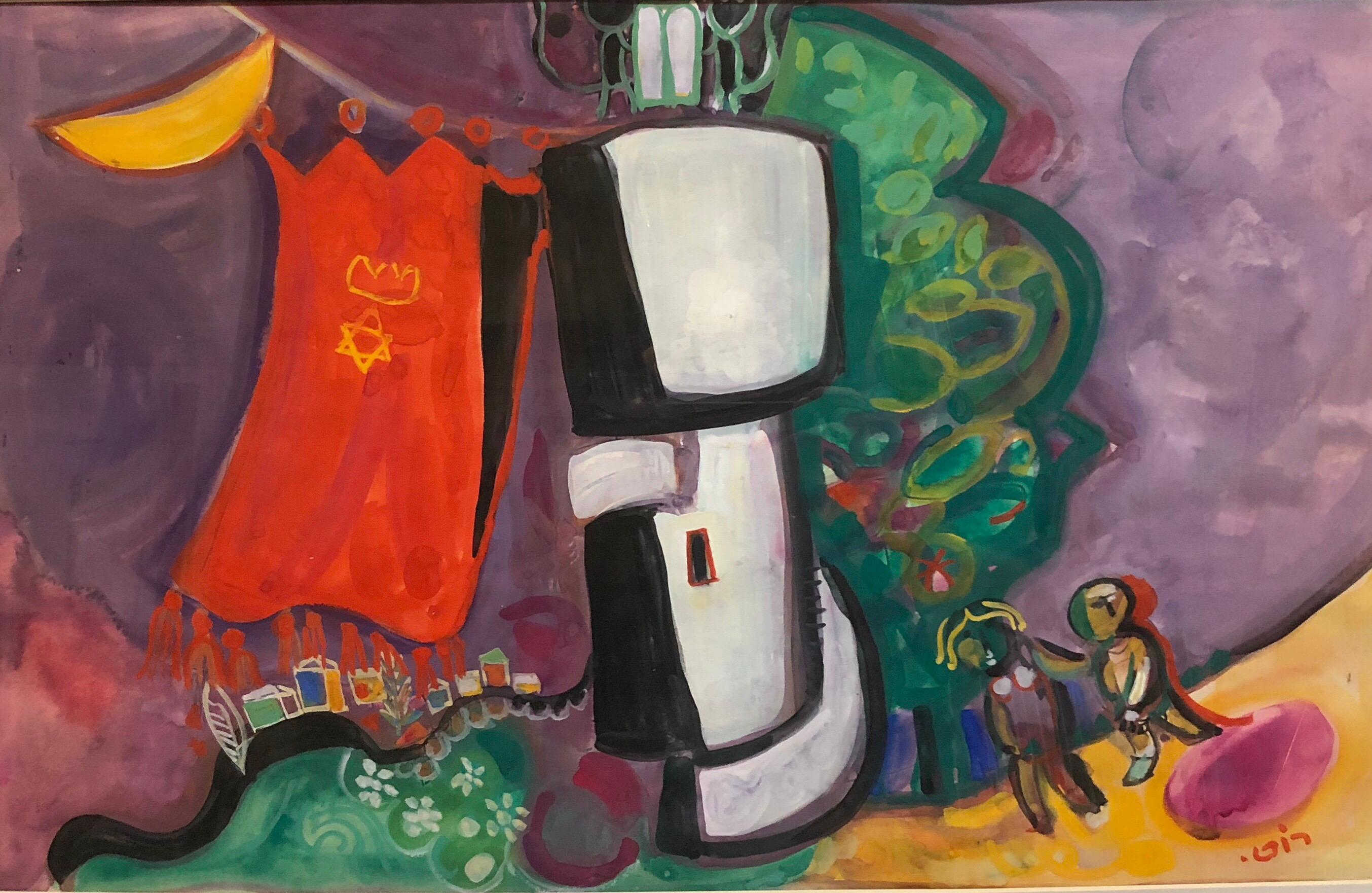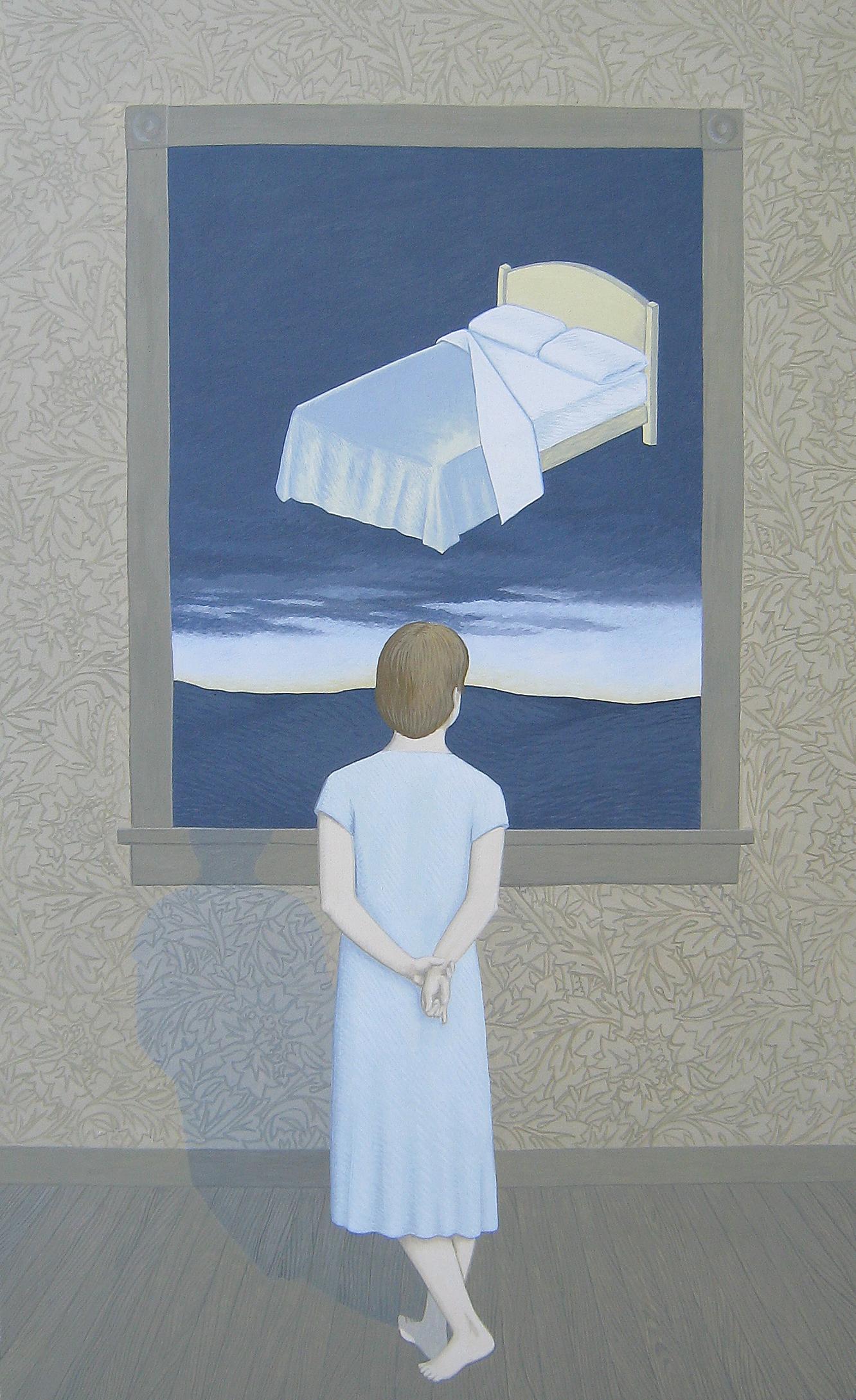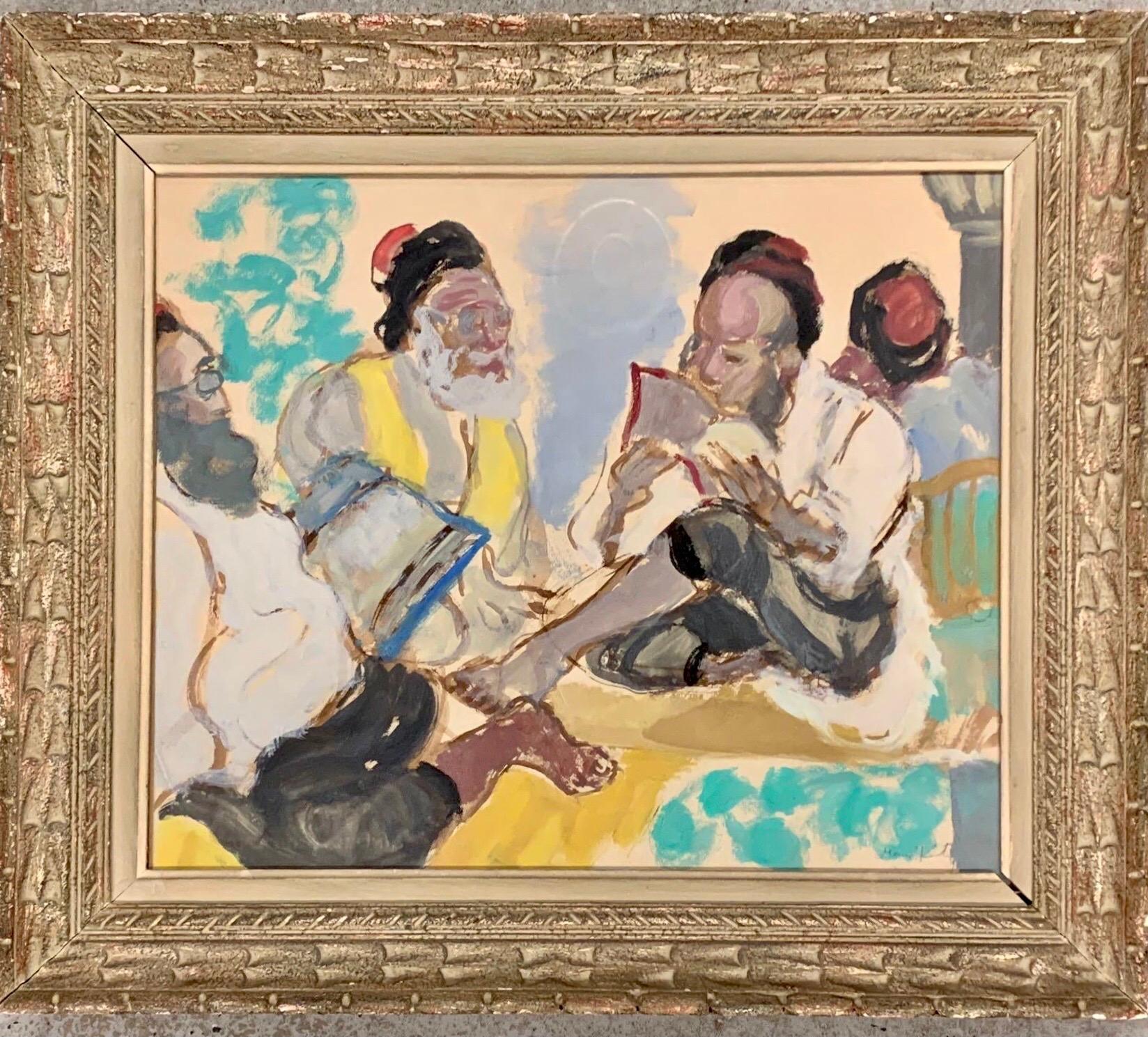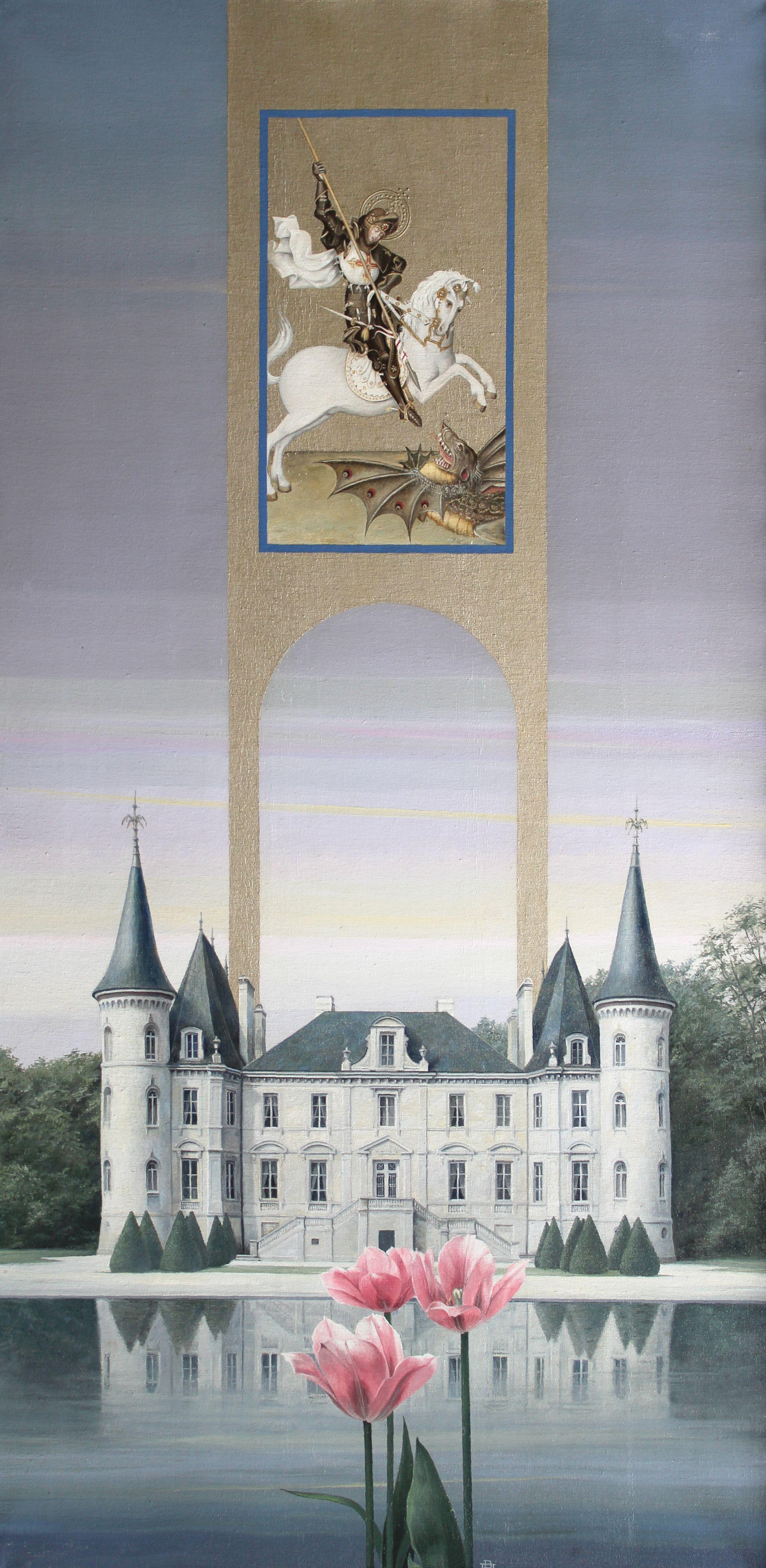Items Similar to Christmas Turkey & the General's Daughter painting by Julio De Diego
Want more images or videos?
Request additional images or videos from the seller
1 of 9
Julio de DiegoChristmas Turkey & the General's Daughter painting by Julio De DiegoCirca 1965
Circa 1965
About the Item
The artwork measures 18" x 24", and the frame 25" x 29.5" x 1.75". Upon request a video clip of this work may be provided.
About this artist:
Julio De Diego crafted a formidable persona within the artistic developments and political struggles of his time. The artist characterized his own work as “lyrical,” explaining, “through the years, the surrealists, the social-conscious painters and the others tried to adopt me, but I went my own way, good, bad or indifferent.” [1] His independence manifested early in life when de Diego left his parent’s home in Madrid, Spain, in adolescence following his father’s attempts to curtail his artistic aspirations. At the age of fifteen he held his first exhibition, set up within a gambling casino. He managed to acquire an apprenticeship in a studio producing scenery for Madrid’s operas, but moved from behind the curtains to the stage, trying his hand at acting and performing as an extra in the Ballet Russes’ Petrouchka with Nijinsky. He spent several years in the Spanish army, including a six-month stretch in the Rif War of 1920 in Northern Africa. His artistic career pushed ahead as he set off for Paris and became familiar with modernism’s forays into abstraction, surrealism, and cubism.
The artist arrived in the U.S. in 1924 and settled in Chicago two years later. He established himself with a commission for the decoration of two chapels in St. Gregory’s Church. He also worked in fashion illustration, designed magazine covers and developed a popular laundry bag for the Hotel Sherman. De Diego began exhibiting through the Art Institute of Chicago in 1929, and participated in the annual Chicago Artists Exhibitions, Annual American Exhibitions, and International Water Color Exhibitions. He held a solo exhibition at the Art Institute of Chicago in the summer of 1935. Though the artist’s career was advancing, his family life had deteriorated. In 1932 his first marriage dissolved, and the couple’s young daughter Kiriki was sent to live with friend Paul Hoffman.
De Diego continued to develop his artistic vocabulary with a growing interest in Mexican art. He traveled throughout the country acquainting himself with the works of muralists such as Carlos Merida, and also began a collection of small native artifacts. While in Mexico, de Diego made a living designing costumes and scenery for ballets. His talents continued to expand as he moved into book illustration, and his work in jewelry making was incorporated into the 1946 Modern Handmade Jewelry exhibition at the Museum of Modern Art. He remarried in 1948, becoming the third husband of Gypsy Rose Lee. The following year the two joined the traveling carnival Royal American Shows. While Gypsy worked as a performer, de Diego developed a show for the carnival using surrealist murals and the performance of Freudian themes. After three years of separation, the couple divorced in Reno, Nevada, and de Diego eventually settled in California.
Julio De Diego continued to impact the world of fine art as he produced interpretive representations of current events in an assortment of techniques. He notably worked in the Renaissance method of “velatura,” building up to as many as forty glazes of oil in each painting. He also commonly worked within gouache, graphite, and mixed media. The themes of his work were as broad in scope as the mediums he worked in, moving from surrealist and folk compositions to self-portraits and politically engaged subjects. In the time spent working for the Works Progress Administration, de Diego produced murals of landscapes and street scenes. Afterwards he pushed away from such brands of realism, asserting, “you can’t transfer nature to canvas, you have to re-invent it.” [2] His paintings of current and historical subjects became constructions both of the artist’s opinion of the facts and his vision of alternate realities. He reacted to natural disasters, produced works on World War II in a manner echoing Goya’s Disasters of War, explored the theme of atomic energy, and commented on the impact of the Cold War. His 1962 Armada series paralleled the use of technology in past and present conflict and explored the notion of defeat. The works played on apocalyptic fears of the Cold War period by invoking the infamous tragedy of the Anglo-Spanish War as well as the ultimate survival of both sides. De Diego expanded his political impact beyond the exhibition of these works, and began voicing opposition to Franco and the rise of fascism. He was a strong supporter of the radical American Artist’s Congress, which spoke in opposition to censorship and the curtailing of rights in Italy and Germany. During these years de Diego also became a teacher and took up positions at the University of Denver and the Artist Equity Workshop.
In the late sixties De Diego settled in the artist’s colony of Sarasota, Florida, and remained there until his death on August 22, 1979. Reports of his years there recounted him as an animated character who entertained with tales of past encounters with famed Surrealists Andre Breton and Max Enrst, the artist Man Ray and influential Peggy Guggenheim. De Diego continued to expand his repertoire by producing the educational film Julio de Diego—Painting in Egg Tempera with the help of local resident Jay Starker. Throughout his years, life and art remained codependent entities within the artist, who noted, “A painting is not what it is, but the memory that we have a life.” [3] Julio de Diego’s works capture the sweeping vision, ambition, and passion of a curious and multifaceted artist.
By Zenobia Grant Wingate
Footnotes:
[1] Peri Tucker, “Artist at Large: Julio de Diego and his worldly-wise works of art.” (St. Petersburg Times, April 1, 1962), page 8.
[2] Ibid.
[3] Marcia Corbino, “A Journey With Julio De Diego 1900-1979.”
- Creator:Julio de Diego (1900-1979, American)
- Creation Year:Circa 1965
- Dimensions:Height: 18 in (45.72 cm)Width: 24 in (60.96 cm)
- Medium:
- Movement & Style:
- Period:
- Condition:
- Gallery Location:Hudson, NY
- Reference Number:
About the Seller
5.0
Vetted Seller
These experienced sellers undergo a comprehensive evaluation by our team of in-house experts.
Established in 1973
1stDibs seller since 2023
5 sales on 1stDibs
Typical response time: <1 hour
- ShippingRetrieving quote...Ships From: Hudson, NY
- Return PolicyThis item cannot be returned.
More From This SellerView All
- A Musician oil painting by Frederick E. WrightLocated in Hudson, NYThis work by Frederick E. Wright is set in an exceptional original Doll & Richards, Boston, frame. The framed dimensions are 16' x 13 1/3" x 1". A hand-written label verso (likely th...Category
Late 19th Century Abstract Impressionist Figurative Paintings
MaterialsOil, Panel
- Bread Bakers oil painting by John BarberBy John BarberLocated in Hudson, NYMeasures 22" x 18" and framed 27" x 24" x 3". About this artist: Born in Galatz, Romania, John Barber became a modernist painter of figures and scenes of...Category
1930s Cubist Figurative Paintings
MaterialsOil, Canvas
- Tlaloc and the Tiger oil painting by Julio de DiegoBy Julio de DiegoLocated in Hudson, NYTlaloc and the Tiger (1939) Oil on panel 16" x 12" 23 ¾" x 18 ¾"x 2 ½" framed Signed and dated (and inscribed) "de Diego 39" lower left. Provenance: The artist; private collection Ch...Category
1930s Surrealist Figurative Paintings
MaterialsPanel, Oil
- Ceremonial Dancers oil and tempera painting by Julio De DiegoBy Julio de DiegoLocated in Hudson, NYArtwork measures 48" x 30" and framed 56 ¼" x 38 ¼" x 3" Provenance: John Heller Gallery, NYC, circa 1975 (label verso) The artist's daughter Corbino Galleries, Sarasota, FL (1990)...Category
1940s Modern Abstract Paintings
MaterialsMasonite, Oil, Tempera
- The Magician oil and tempera painting by Julio de DiegoBy Julio de DiegoLocated in Hudson, NYJulio De Diego’s Atomic Series paintings made an extraordinary statement regarding the shock and fear that accompanied the dawn of the nuclear age. In the artist’s own words, “Scientists were working secretly to develop formidable powers taken from the mysterious depths of the earth - with the power to make the earth useless! Then, the EXPLOSION! . . . we entered the Atomic Age, and from there the neo-Atomic war begins. Explosions fell everywhere and man kept on fighting, discovering he could fight without flesh.” To execute these works, De Diego developed a technique of using tempera underpainting before applying layer upon layer of pigmented oil glazes. The result is paintings with surfaces which were described as “bonelike” in quality. The forms seem to float freely, creating a three-dimensional visual effect. In the 1954 book The Modern Renaissance in American Art, author Ralph Pearson summarizes the series as “a fantastic interpretation of a weighty theme. Perhaps it is well to let fantasy and irony appear to lighten the devastating impact. By inverse action, they may in fact increase its weight.” Exhibited 1964 Marion Koogler McNay Art Institute, San Antonio, Texas This work retains its original frame which measures 54" x 42" x 2" About this artist: Julio De Diego crafted a formidable persona within the artistic developments and political struggles of his time. The artist characterized his own work as “lyrical,” explaining, “through the years, the surrealists, the social-conscious painters and the others tried to adopt me, but I went my own way, good, bad or indifferent.” [1] His independence manifested early in life when de Diego left his parent’s home in Madrid, Spain, in adolescence following his father’s attempts to curtail his artistic aspirations. At the age of fifteen he held his first exhibition, set up within a gambling casino. He managed to acquire an apprenticeship in a studio producing scenery for Madrid’s operas, but moved from behind the curtains to the stage, trying his hand at acting and performing as an extra in the Ballet Russes’ Petrouchka with Nijinsky. He spent several years in the Spanish army, including a six-month stretch in the Rif War of 1920 in Northern Africa. His artistic career pushed ahead as he set off for Paris and became familiar with modernism’s forays into abstraction, surrealism, and cubism. The artist arrived in the U.S. in 1924 and settled in Chicago two years later. He established himself with a commission for the decoration of two chapels in St. Gregory’s Church. He also worked in fashion illustration, designed magazine covers and developed a popular laundry bag for the Hotel Sherman. De Diego began exhibiting through the Art Institute of Chicago in 1929, and participated in the annual Chicago Artists Exhibitions, Annual American Exhibitions, and International Water Color Exhibitions. He held a solo exhibition at the Art Institute of Chicago in the summer of 1935. Though the artist’s career was advancing, his family life had deteriorated. In 1932 his first marriage dissolved, and the couple’s young daughter Kiriki was sent to live with friend Paul Hoffman. De Diego continued to develop his artistic vocabulary with a growing interest in Mexican art. He traveled throughout the country acquainting himself with the works of muralists such as Carlos Merida, and also began a collection of small native artifacts...Category
1940s American Modern Abstract Paintings
MaterialsMasonite, Oil, Tempera
- St. Atomic oil and tempera painting by Julio de DiegoBy Julio de DiegoLocated in Hudson, NYJulio De Diego’s Atomic Series paintings made an extraordinary statement regarding the shock and fear that accompanied the dawn of the nuclear age. In the artist’s own words, “Scientists were working secretly to develop formidable powers taken from the mysterious depths of the earth - with the power to make the earth useless! Then, the EXPLOSION! . . . we entered the Atomic Age, and from there the neo-Atomic war begins. Explosions fell everywhere and man kept on fighting, discovering he could fight without flesh.” To execute these works, De Diego developed a technique of using tempera underpainting before applying layer upon layer of pigmented oil glazes. The result is paintings with surfaces which were described as “bonelike” in quality. The forms seem to float freely, creating a three-dimensional visual effect. In the 1954 book The Modern Renaissance in American Art, author Ralph Pearson summarizes the series as “a fantastic interpretation of a weighty theme. Perhaps it is well to let fantasy and irony appear to lighten the devastating impact. By inverse action, they may in fact increase its weight.” Exhibited 1950 University of Illinois at Urbana "Contemporary American Painting" 1964 Marion Koogler McNay Art Institute, San Antonio, Texas This work retains its original frame which measures 54" x 36" x 2". About this artist: Julio De Diego crafted a formidable persona within the artistic developments and political struggles of his time. The artist characterized his own work as “lyrical,” explaining, “through the years, the surrealists, the social-conscious painters and the others tried to adopt me, but I went my own way, good, bad or indifferent.” [1] His independence manifested early in life when de Diego left his parent’s home in Madrid, Spain, in adolescence following his father’s attempts to curtail his artistic aspirations. At the age of fifteen he held his first exhibition, set up within a gambling casino. He managed to acquire an apprenticeship in a studio producing scenery for Madrid’s operas, but moved from behind the curtains to the stage, trying his hand at acting and performing as an extra in the Ballet Russes’ Petrouchka with Nijinsky. He spent several years in the Spanish army, including a six-month stretch in the Rif War of 1920 in Northern Africa. His artistic career pushed ahead as he set off for Paris and became familiar with modernism’s forays into abstraction, surrealism, and cubism. The artist arrived in the U.S. in 1924 and settled in Chicago two years later. He established himself with a commission for the decoration of two chapels in St. Gregory’s Church. He also worked in fashion illustration, designed magazine covers and developed a popular laundry bag for the Hotel Sherman. De Diego began exhibiting through the Art Institute of Chicago in 1929, and participated in the annual Chicago Artists Exhibitions, Annual American Exhibitions, and International Water Color Exhibitions. He held a solo exhibition at the Art Institute of Chicago in the summer of 1935. Though the artist’s career was advancing, his family life had deteriorated. In 1932 his first marriage dissolved, and the couple’s young daughter Kiriki was sent to live with friend Paul Hoffman. De Diego continued to develop his artistic vocabulary with a growing interest in Mexican art. He traveled throughout the country acquainting himself with the works of muralists such as Carlos Merida, and also began a collection of small native artifacts...Category
1940s American Modern Abstract Paintings
MaterialsMasonite, Oil, Tempera
You May Also Like
- Israeli Kibbutz Artist Judaica Shul Torah Ark Surrealist Gouache PaintingBy Leo RothLocated in Surfside, FLLeo Roth (1914–2002), also known as Lior Roth, was an Israeli painter, born in 1914 in Austria-Hungary. (later Poland) In 1920, Roth moved to Germany and, in 1933, immigrated to Palestine. He studied at the École des Beaux-Arts in Paris and completed frescoes in Italy and France in the 1950s. Roth first settled in Tel Aviv, then moved to Kvutzat Kinneret, then finally to Kibbutz Afikim where he remained until his death. He served as Director of the Art Academy of the Kibbutzim. In 1959, he was awarded the Jordan Valley Prize for Painting. Roth exhibited in the United States, Israel, Mexico, Spain, Holland, Sweden, and Denmark. He died in 2002. Education: 1930 School of Art, Duisberg-Hamborn, Germany, under Josef Doppelfeld Academy of Fine Arts, Hamburg, Germany 1951 Fresco and mural painting, Ecole nationale superiere des Beaux-Arts, Paris, France 1951 fresco in Italy Teaching: Director of Art Academy of the Kibbutzim Roth's work was influenced by Cubism and bears much in common with the work of compatriot painter Naftali Bezem. His colourful canvases contain biblical imagery and references to early Israeli pioneer culture. Selected Solo Exhibitions 2015 Home, Montefiore Art Gallery, Tel Aviv 2009 Kibbutz Machanayim Art Gallery 2000 Retrospective, Museum of Art, Kibbutz Ein Harod 1997 Oil paintings, Kibbutz Machanayim Art Gallery 1993 Solo Exhibition, Beit Yad Lebanim, Tiberias 1983 Oil paintings, ''Bet-Emanuel'', Ramat Gan 1980 Wilfrid Israel Museum, Oriental Art and Studies, Kibbutz Hazorea 1977 Tiroche Gallery, Old Jaffa 1976 Hatzrif Art Gallery, Be'er Sheva 1957 Oil paintings, Tel Aviv Art Museum 1950 Katz Gallery, Tel AvivSelected exhibitions 2000: Chaim Atar Art Museum, Ein Harod, Israel: The Works of Leo Roth: An Exhibition Selected Group Exhibitions 2014 Revelations, Jerusalem Print Workshop 2013 Group Exhibition, Yair Art Gallery, Tel Aviv 2008 The First Decade: Hegemony and Plurality, Ein Harod Art Museum 2000 Group...Category
20th Century Surrealist Interior Paintings
MaterialsPaper, Gouache
- Bed, Original Contemporary Surrealist Gouache Painting on Wood PanelBy Megan FrazerLocated in Boston, MABed, Original Contemporary Surrealist Painting, 2012 18" x 11.25" x 1.625" (HxWxD) This muted, dream-like surrealist painting by artist Megan Frazer can be compared to both the subject matter and painterly style of the work of Leonara Carrington...Category
21st Century and Contemporary Surrealist Interior Paintings
MaterialsGouache, Wood Panel
- Watching, Original Contemporary Surrealist Gouache Painting on Wood PanelBy Megan FrazerLocated in Boston, MAWatching, Original Contemporary Surrealist Painting, 2014 11.25" x 18" x 1.625" (HxWxD) Gouache on Wood Panel This surreal gouache painting features a woman laying on top of her bed...Category
21st Century and Contemporary Surrealist Figurative Paintings
MaterialsGouache, Wood Panel
- Russian French Judaica Jewish Gouache Painting Sephardic Rabbi, Jerusalem IsraelBy Mane KatzLocated in Surfside, FLMané-Katz (1894 - 1962) SCHOLARS AT STUDY Signed Mané Katz (lower right) Tempera (gouache) on paper laid down on card. 19 3/4 by 23 5/8 in. (50.2 by 60.1 cm) sight size. Frame size is 27 X 31 inches. Provenance: Sotheby's Impressionist & Modern art, 8 June 2017 (consigned by original owner who purchased it directly from artist) Mane-Katz (1894-1962) was a Litvak painter born in Ukraine best known for his depictions of the Jewish shtetl in Eastern Europe. Emmanuel Mané-Katz (Hebrew:מאנה כץ), born Mane Leyzerovich Kats (1894–1962), was a Litvak painter born in Kremenchuk, Ukraine, best known for his depictions of the Jewish shtetl in Eastern Europe. Particularly music figures and Jewish wedding scenes. Mane-Katz moved to Paris at the age of 19 to study art, although his father wanted him to be a rabbi. During the First World War he returned to Russia, at first working and exhibiting in Petrograd; following the October revolution, he traveled back to Kremenchuk, where he taught art. In 1921, due to the ongoing fighting in his hometown during the civil war, he moved once again to Paris. There he became friends with Pablo Picasso and other important French artists, and was affiliated with the art movement known as the School of Paris; together with other outstanding Jewish artists of that milieu, he is sometimes considered to be part of a group referred to specifically as the Jewish School of Paris. Includes Russian, Ukrainian and Polish painters Jankel Adler, Arbit Blatas, Marc Chagall, Jacques Chapiro, Michel Kikoine, Pinchus Kremegne, Sigmund Menkes, Jules Pascin, Issachar Ryback, Jacques Lipchitz,Chana Orloff, and Ossip Zadkine. Ecole de Paris In 1931, Mane-Katz's painting The Wailing Wall was awarded a gold medal at the Paris World's Fair. Early on, his style was classical and somber, but his palette changed in later years to bright, primary colors, with an emphasis on Jewish themes. His oils feature Judaic Hasidic characters, rabbis, Jewish musicians, beggars, yeshiva students and scenes from the East European shtetl made famous in the west by Sholem Aleichem and Tevye. Mane-Katz made his first trip to Mandate Palestine in 1928, and thereafter visited the country annually. He said his actual home was Paris, but his spiritual home was Eretz Yisrael, the Land of Israel. In 1939, as World War II was breaking out, he was drafted by the French and then was taken prisoner by the Germans. He escaped and went to the United States and remained there until 1945, exhibiting his paintings at Katia Granoff Gallery and Wildenstein Gallery. After the war, he returned to Paris where he had exhibited in the Salons. In Paris to the end of his career, he worked happily, painting hundreds of portraits of rabbis...Category
Mid-20th Century Modern Figurative Paintings
MaterialsTempera, Gouache
- Avant-garde Surrealism Last Supper in Modern Brush Strokes of Dark Cool TonesLocated in ALCOY/ALCOI, ES«Última cena» Collection: Muses Description: Acrylic on canvas, figurative, dark, Surrealism, modern "When a successful man with social prestige is pursued by some women who only see him as a means to take advantage of his success, without realizing that they are being watched by the owner of his heart." The artwork in question may be a visual representation of the complex dynamics at play in a love triangle. The man is described as successful and prestigious, with a position of power and influence that makes him a target for women who seek to take advantage of his status. However, there is also a suggestion that the man is not free to pursue these women, as he is already claimed by someone else. The focus is on the emotional tension and drama of the situation, with the viewer invited to imagine the thoughts and feelings of all parties involved. The artwork may convey a sense of longing, jealousy, or betrayal, with the owner of the man's heart struggling to come to terms with the attention he is receiving from other women. Overall, the artwork explores the complexities of love and desire, as well as the ways in which social status and power can impact our relationships with others. Victoria...Category
2010s Surrealist Figurative Paintings
MaterialsCanvas, Acrylic
- Château Pichon-Longueville. 1994. Canvas, oil, 80x40 cmLocated in Riga, LVChâteau Pichon-Longueville. 1994. Canvas, oil, 80x40 cm Vladimirs Pavlovs (1950) Born May 6, 1950 in Riga. In 1981 he graduated from the department of artistic construction of the A...Category
1990s Surrealist Interior Paintings
MaterialsCanvas, Oil
Recently Viewed
View AllMore Ways To Browse
Oil Painting T Tucker
T Denver Painting
1st World War Jewelry
Extra Small Oil Paintings
Tales Of Hoffman
Chapel Interior
Vintage Rose Artwork
Vintage Native American Artifacts
Spanish Artifacts
Cubism Realism
Vintage Scenery Paintings
Vintage Scenery Painting
Vintage Roses Book
Vintage Rose Book
T Tucker
Vintage Nature Illustration





